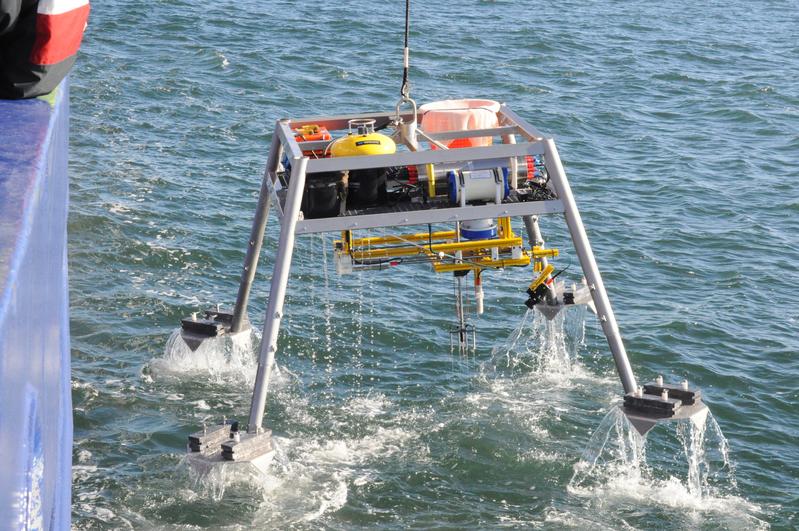

LanceALot en route to a deployment. The device allows the simultaneous measurement of current velocity, seafloor oxygen concentration and bedform.
Max Planck Institute for Marine Microbiology
Each year, close to five million Germans spent their holidays at the North Sea, relaxing on the beach or enjoying the beautiful nature of the Wadden Sea. However, the North Sea is more than just one of Germany’s top tourist destinations. It is also a fascinating ecosystem, significant for our everyday life and always good for a surprise.
That is why Soeren Ahmerkamp and David Probandt from the Max Planck Institute for Marine Microbiology in Bremen spend a lot of time at the North Sea. The two researchers focus on sands – or, scientifically spoken, permeable coastal sediments. In two new publications the researchers describe how oxygen travels through the sand and what that means for the resident bacterial community.
„Sands cover large parts of the seafloor along the continental margins”, Soeren Ahmerkamp from the Department of Biogeochemistry at the MPI Bremen explains. „These sediments are much more permeable – meaning oxygen can penetrate much easier than the mostly muddy sediments of the deep ocean.“
When seawater is flushed through the sand it also transports oxygen into the seafloor, thereby stimulating the resident microorganisms. The more oxygen arrives, the more active the microorganisms are. That allows them to turn over large amounts of carbon and nitrogen, for example. „This is particularly important considering that rivers transport large amounts of nitrogen and other nutrients to the North Sea“, says David Probandt from MPI Bremen’s Department of Molecular Ecology.
„Until now, the interaction of sands and seawater was mainly investigated under laboratory conditions”, Ahmerkamp points out. “It is essential to investigate these processes under natural conditions to validate the laboratory findings and estimate their importance.”
Together with colleagues from the MPI Bremen, Ahmerkamp therefore developed a robot named LanceALot, which simultaneously scans the sea floor, measures the current velocity and determines the oxygen concentrations in the sand. LanceALot was deployed at 16 different locations in the North Sea to investigate the interplay of the controlling factors.
Ripples – the typical sand waves reminding of corrugated iron – play an important role. „The continuous movement of the ripples and changing tidal flows make sand a highly dynamic, i.e. a constantly constantly changing environment. Sometimes oxygen is present, sometimes it is not. Sometimes it penetrates several centimetres into the sand and a few minutes later it only reaches down to a few millimetres – the microorganisms need to adapt to this changing conditions”, Ahmerkamp says.
Thus, the sedimentary bacteria have to be flexible. „Each individual sand grain is a home to tens to hundreds of thousands of bacteria. Of course, they can set quite a few things in motion”, David Probandt points out. For example, as the bacteria remineralize carbon and nitrogen from the seawater, they transform these sands into giant filters. A lot of the substances carried into the sand with the seawater do not come out again. Thus, these substances are removed from the water.
To date, little is known about the bacterial inhabitants of the coast. Probandt and his colleagues took a close look at them with state-of-the-art molecular techniques and fluorescence microscopy. „Already in the uppermost five millimetres of the sediment, we find very different and much more diverse bacteria than in the seawater”, says Probandt.
„Who lives where is mainly determined by the composition of the seafloor. The more permeable it is for intruding seawater, the more aerobic bacteria we find.” The study also revealed that one group of bacteria, so-called Planctomycetes, are particularly abundant in coastal sediments. As opposed to other bacteria, Planctomycetes have a very complex life cycle and produce a variety of natural products. They could therefore also be specifically adapted to conditions in highly dynamic surface sediments. „Next, we want to find out if this is indeed the case“ Probandt emphasizes.
The sea floor along the coasts is heavily affected by human activities – from economic usage to nutrient input and climate change. The new studies point out the complexity of this habitat and the importance of its inhabitants. „The close cooperation of scientists from different disciplines allowed us to gain many new insights about this dynamic ecosystem “, stresses Probandt.
„There is still a lot to investigate in the North Sea and other coastal seas“, Ahmerkamp concludes. „The processes in these ecosystems and possible changes affect all of us.”
Original publications
S. Ahmerkamp, C. Winter, K. Krämer, D. de Beer, F. Janssen, J. Friedrichs, M. Kuypers und M. Holtappels (2017): Regulation of benthic oxygen fluxes in permeable sediments of the coastal ocean. Limnology and Oceanography.
DOI: 10.1002/lno.10544 (http://onlinelibrary.wiley.com/doi/10.1002/lno.10544/full)
This paper was produced in the framework of the MPI-marum cross-cutting-project 5 (CCP5) “Organic-matter remineralization and nutrient turnover in permeable sandy sediments”.
D. Probandt,. K. Knittel, H. E. Tegetmeyer, S. Ahmerkamp, M. Holtappels und R. Amann (2017): Permeability shapes bacterial communities in sublittoral surface sediments. Environmental Microbiology 19(4): 1584-1599.
DOI: 10.1111/1462-2920.13676 (http://onlinelibrary.wiley.com/doi/10.1111/1462-2920.13676/epdf)
Please direct your queries to
Dr. Soeren Ahmerkamp (https://www.mpi-bremen.de/Dr.-soeren-ahmerkamp.html)
David Probandt (https://www.mpi-bremen.de/David-Probandt.html)
or the press office
Dr. Fanni Aspetsberger
Dr. Manfred Schlösser
Phone: +49 421 2028 704
E-Mail: presse(at)mpi-bremen.de












